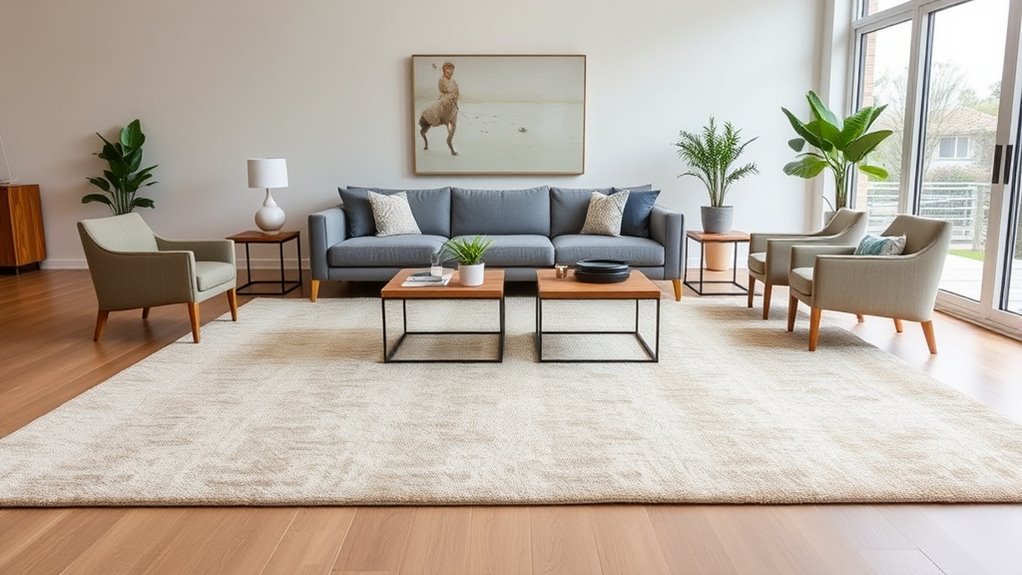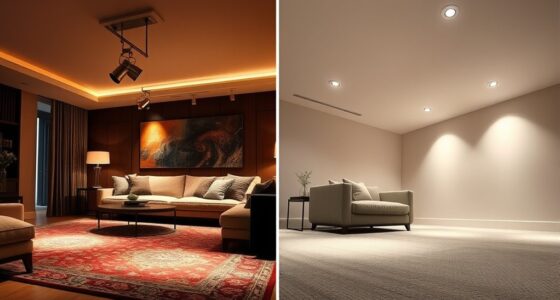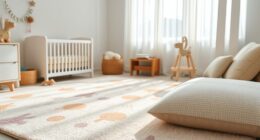To perfect your rug size and placement, measure your room and furniture carefully to guarantee proper fit and balance. Choose a rug that complements the room’s layout, with enough space around edges, usually 18-24 inches, and ensure key furniture pieces sit comfortably on it. Play with shapes, layering, and zone areas for visual interest. Keeping proportions harmonious creates a cohesive look. Keep exploring these designer tricks to make your space truly stand out.
Key Takeaways
- Measure your room and furniture accurately to select a rug that complements the space without overwhelming it.
- Ensure front legs of sofas and chairs sit on the rug to anchor furniture and create a cohesive look.
- Choose rug shapes that enhance your layout, like rectangular for larger spaces or round for focal points.
- Maintain 18-24 inches of bare floor around the rug edges for proper placement and visual balance.
- Layer rugs with contrasting textures or patterns to add visual interest and define different zones effectively.
Measure Your Space Carefully Before Selecting a Rug
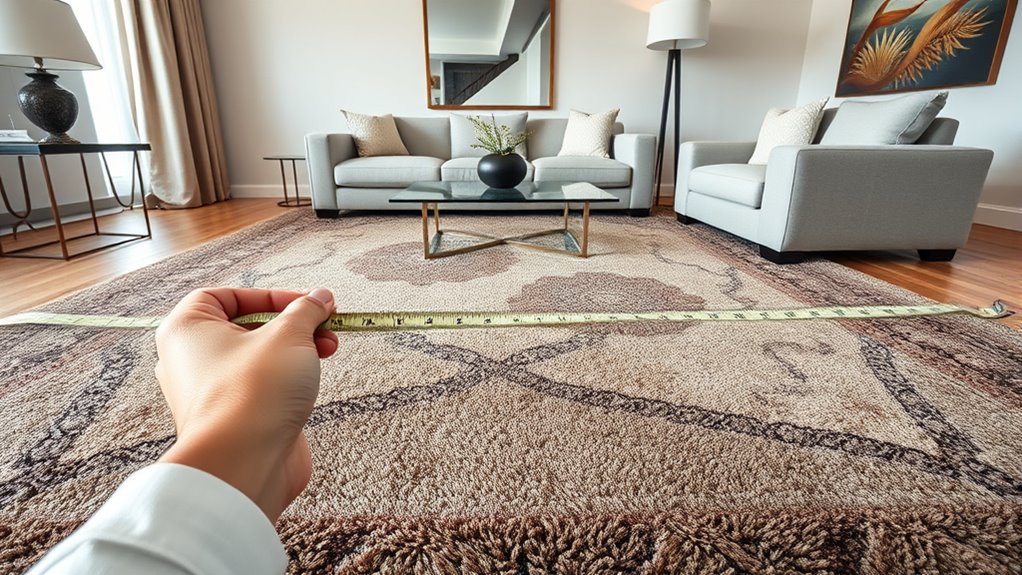
Before choosing a rug, it is vital to measure your space accurately. Grab a tape measure and note down the length and width of the area you want to cover. Don’t rely on visual estimates; precise measurements prevent buying a rug that’s too small or too large. Consider the furniture placement and how much of the floor you want visible around the rug’s edges. Measure from wall to wall, accounting for any architectural features or irregularities in the room. Write down these measurements clearly. This step guarantees you select a rug that fits perfectly, enhances your space, and maintains proper proportions. Paying attention to room proportions ensures the rug complements your décor and does not overwhelm or underwhelm the space. Taking the time to measure carefully makes your decorating process smoother and results in a more polished, balanced look.
Choose the Right Rug Size for Your Room’s Layout
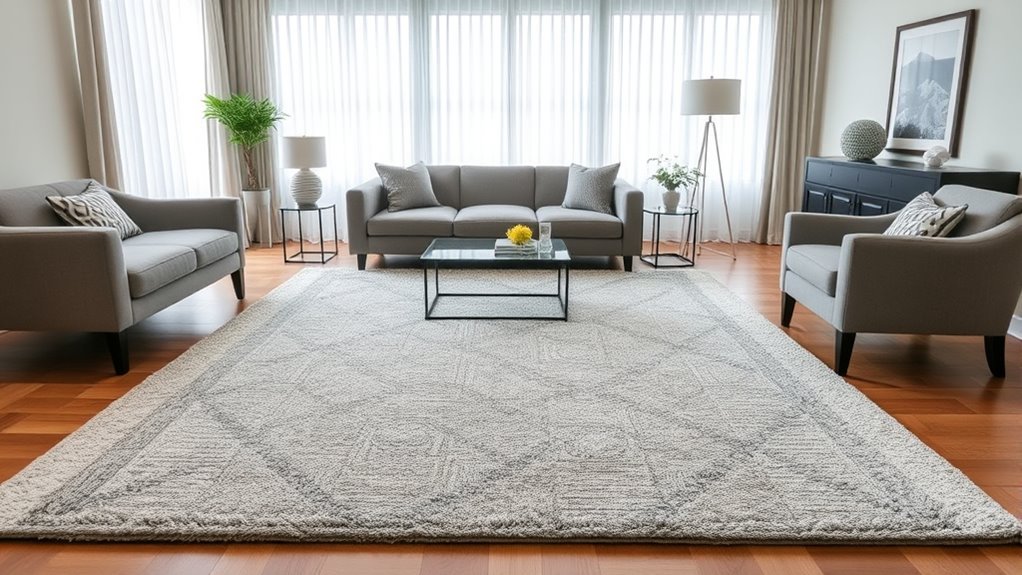
To choose the right rug size, you need to measure your space accurately and consider how your furniture is arranged. Think about the shape of your room and select a rug that complements it, whether rectangular, round, or irregular. Picking the right size guarantees your rug enhances your room’s layout without overwhelming or underwhelming the space. Additionally, paying attention to the room’s layout and how furniture placement interacts with the rug ensures a cohesive and inviting farmhouse bedroom design.
Measure Your Space Carefully
Measuring your space accurately is essential to choosing the right rug size for your room’s layout. Start by noting the room’s length and width with a tape measure. Next, consider the areas where you want the rug to make an impact: 1. Identify key furniture zones to ensure the rug complements your layout. 2. Measure the distances from wall to furniture to see how much rug coverage you need. 3. Think about clearance space around furniture for a balanced look. Additionally, understanding contrast ratio can help you select rugs that enhance the visual depth and overall aesthetic of your space.
Consider Furniture Placement
Once you’ve measured your space, focus on how your furniture is arranged within the room. Your rug should complement this layout, not compete with it. If you have a seating area, aim for the front legs of your sofas and chairs to sit on the rug, anchoring the space. For a dining room, the rug should be large enough to fit the table and extend beyond the chairs when pulled out. In smaller rooms, consider a rug that fits beneath key furniture pieces without overwhelming the space. Think about the flow—your rug should enhance movement and not create obstacles. By aligning your rug size with your furniture placement, you create a cohesive look that feels intentional and well-balanced. Proper interior layout ensures your rug enhances the overall design and functionality of your space.
Opt for Suitable Rug Shape
Choosing the right rug shape is essential to complement your room’s layout and maximize its visual appeal. The shape can define space flow and highlight key design features. To find the perfect fit, consider these options:
- Rectangular rugs: Ideal for larger rooms or when framing furniture like sofas and beds, creating a cohesive look.
- Round rugs: Perfect for softening sharp angles, adding a focal point, or fitting in smaller spaces like entryways.
- Square rugs: Great for defining seating areas in square or grid-like rooms, providing balance and symmetry.
Select a shape that aligns with your furniture arrangement and enhances the room’s overall harmony. The right shape ties the space together seamlessly. Additionally, consider how water parks can serve as inspiring ideas for playful and dynamic interior design themes that incorporate bold shapes and layouts.
Ensure Proper Rug Placement Around Furniture
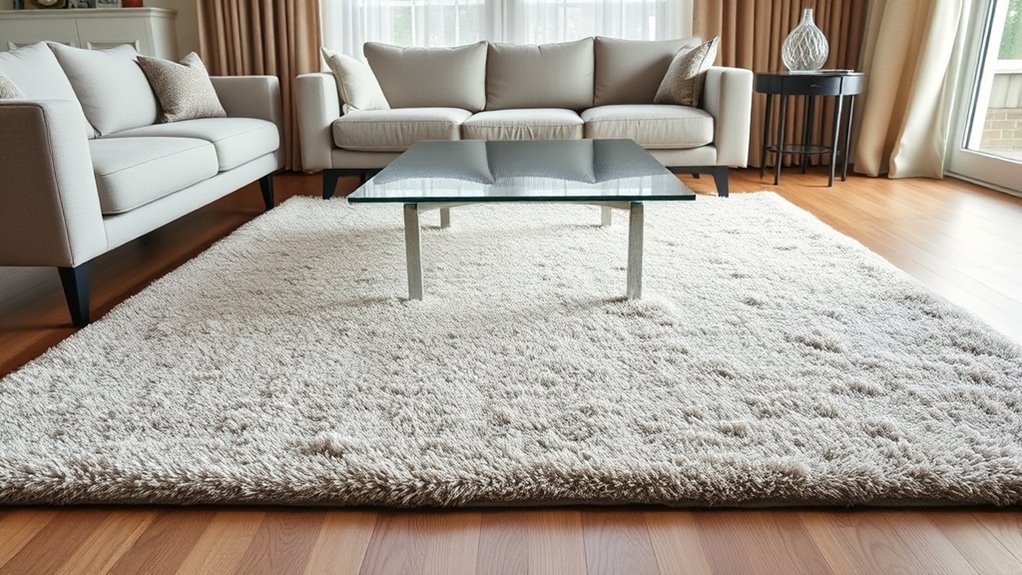
To guarantee your rug fits perfectly around your furniture, start by measuring your pieces accurately. Choose a rug shape that complements your layout and keeps enough space around the edges. Maintaining clear borders prevents the rug from looking crowded and creates a balanced, polished look. Incorporating principles of space planning ensures your rug placement enhances the overall room design.
Measure Furniture Dimensions
Measuring your furniture dimensions accurately is essential for ensuring proper rug placement. To get it right, follow these steps:
- Measure the length and width of each piece of furniture, like sofas, chairs, or tables, to know their exact size.
- Note the height of your furniture, especially for items like beds or tall cabinets, to determine how much rug area is needed around them.
- Record the distance from furniture edges to the rug’s desired placement, ensuring enough space for walking and visual balance.
Choose Rug Shape Carefully
Selecting the right rug shape can considerably impact how furniture fits and looks in your space. The shape influences the overall flow and balance of the room. For a rectangular sofa, a rectangular or runner rug works best, creating a cohesive frame. Round rugs soften the room’s angles and add visual interest, especially with curved furniture or open floor plans. Square rugs suit smaller seating areas or compact spaces, making them feel cozy and contained. Consider how the shape interacts with your furniture’s placement—aim for the rug to complement rather than compete with it. Properly choosing the shape guarantees your furniture feels anchored and harmonious. Additionally, integrating rug size appropriately ensures that the proportions are balanced and the space feels well-designed. Remember, the right shape enhances the room’s style while ensuring practical placement.
Maintain Clear Space Borders
Maintaining clear space borders around your rug guarantees a balanced and cohesive look in your space. Proper placement ensures furniture doesn’t overpower the rug or look out of place. Here are three key tips:
- Leave at least 18-24 inches of bare floor around the rug’s edges to create visual breathing room.
- Position furniture so that the front legs rest on the rug while the back legs stay on the floor, anchoring the area without crowding.
- Keep walkways clear by ensuring the rug doesn’t block traffic flow, maintaining safety and accessibility.
- Remember that attention and consistent practice in arranging your space can enhance your ability to create a harmonious environment.
Maintain Consistent Rug Edges for a Cohesive Look
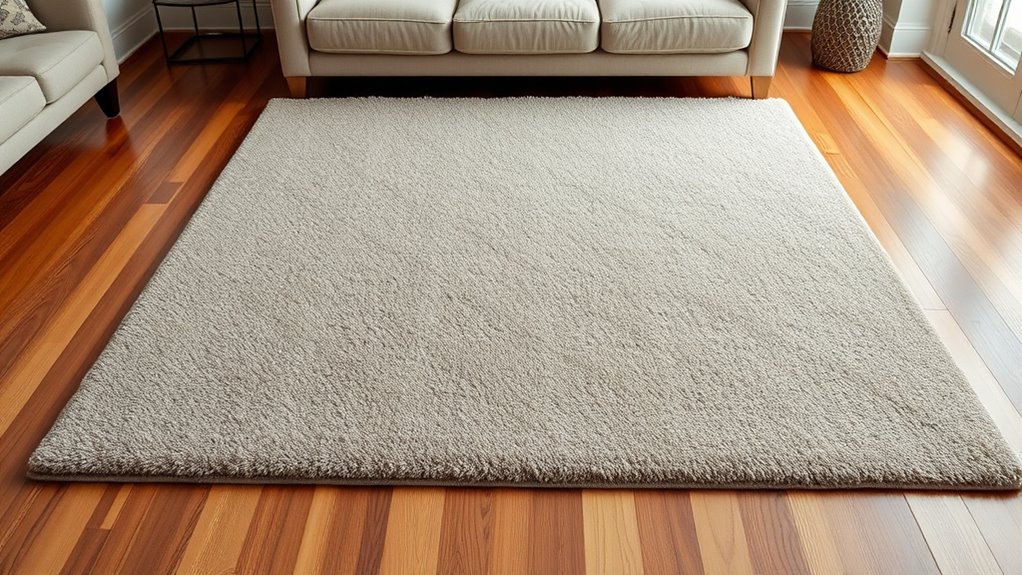
To create a polished, cohesive look, maintaining the edges of your rugs consistent across different areas is vital. You want your rugs to flow seamlessly, so choose similar shapes and border styles throughout your space. If one rug has a raw, frayed edge, while another features a clean, bound finish, it can disrupt visual harmony. Make sure your rugs align in size and shape, especially when placed next to each other, to avoid awkward gaps or overlaps. Use matching or complementary trimming techniques to guarantee edges look uniform. Consistent edges help draw the eye smoothly across your rooms, tying the decor together. When edges are uniform, your space appears intentional, balanced, and thoughtfully designed. Incorporating interior design principles can further enhance the overall cohesiveness of your decor.
Use Multiple Rugs to Define Different Zones
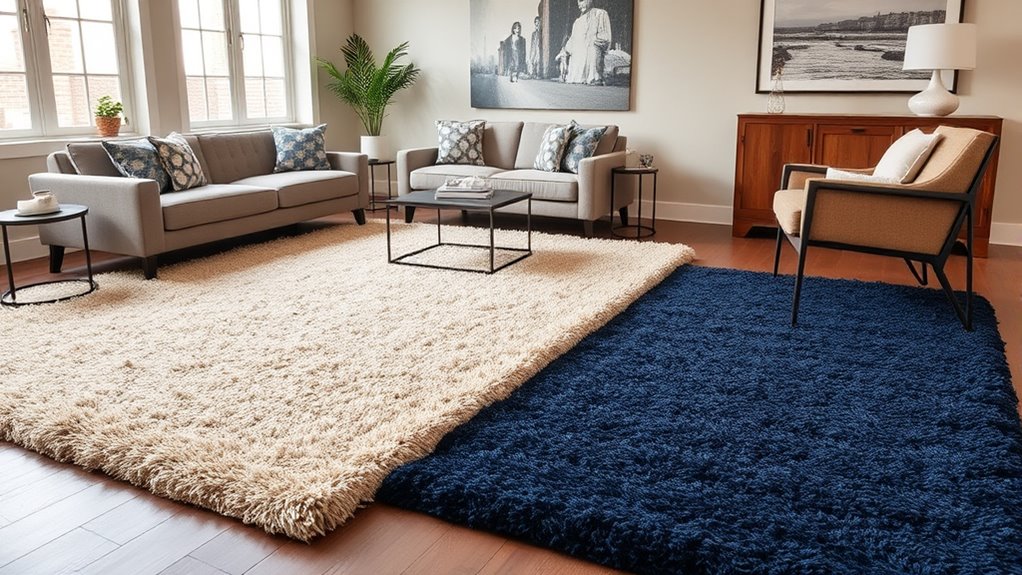
Using multiple rugs is an effective way to define distinct zones within an open-plan space. It helps create visual separation without walls or partitions. To do this effectively, consider these tips:
- Place rugs under key furniture pieces to anchor each zone, like your sofa and coffee table.
- Vary rug sizes to suit each area’s function, such as a larger rug for the living room and smaller ones for reading nooks.
- Use contrasting patterns or colors to visually distinguish different zones, adding personality and clarity.
- Pay attention to personality traits like active listening and empathy to foster a welcoming environment within each zone.
This approach not only maximizes your space but also creates a cozy, organized atmosphere. Make sure each rug complements the overall decor, uniting the zones while maintaining their individual identities.
Consider Rug Material and Texture for Comfort and Style
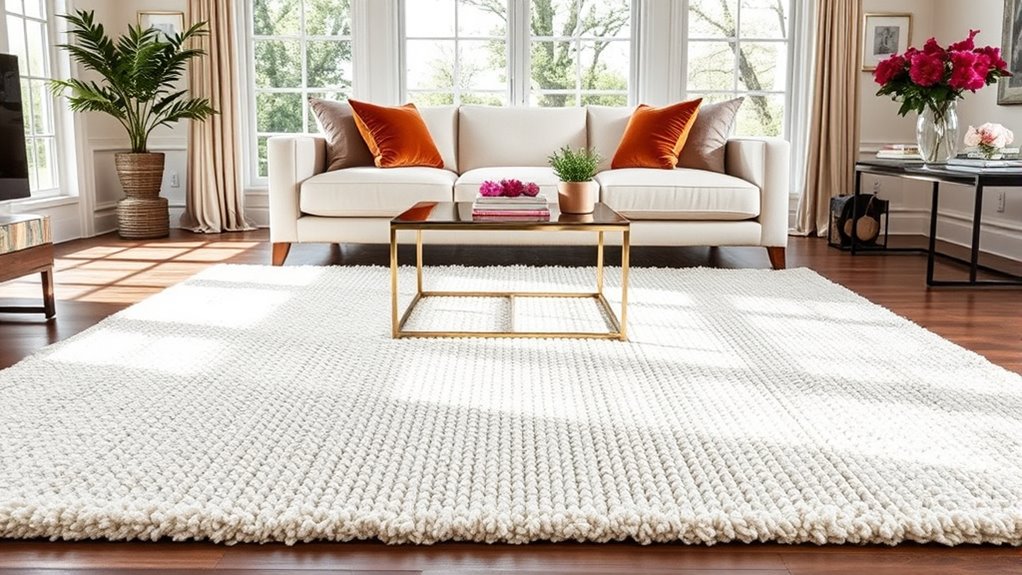
Choosing the right rug material and texture can substantially enhance both comfort and style in your space. If you want softness underfoot, opt for plush wool or shag rugs, perfect for cozy areas like living rooms or bedrooms. For a sleek, modern look, choose low-pile materials such as nylon or polypropylene, which are easy to clean and durable. Natural fibers like jute or sisal add texture and an earthy vibe, ideal for casual or rustic settings. Keep in mind that textured rugs can create visual interest and contrast with furniture, while smooth designs bring a refined, minimal feel. By selecting a material that aligns with your lifestyle and aesthetic, you guarantee your rug not only looks great but also feels comfortable every day.
Use Rugs to Frame and Highlight Key Furniture Pieces
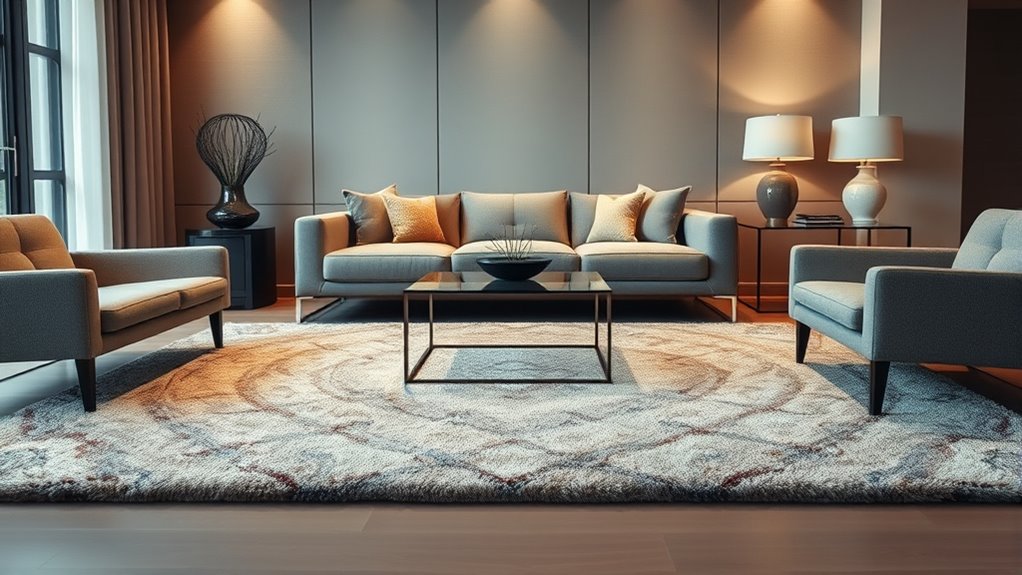
Placing a rug around key furniture pieces instantly draws attention and defines different zones within a room. To make the most of this, consider these tips:
A rug around key furniture highlights zones and adds visual cohesion to your room.
- Size matters: Choose a rug large enough to fit all furniture legs, creating a unified look.
- Placement: Position the rug so the front legs of sofas and chairs rest on it, anchoring the seating area.
- Highlight focal points: Use a rug to frame a statement piece like a coffee table or a dining table, making it stand out.
Play With Layering Rugs for Visual Interest
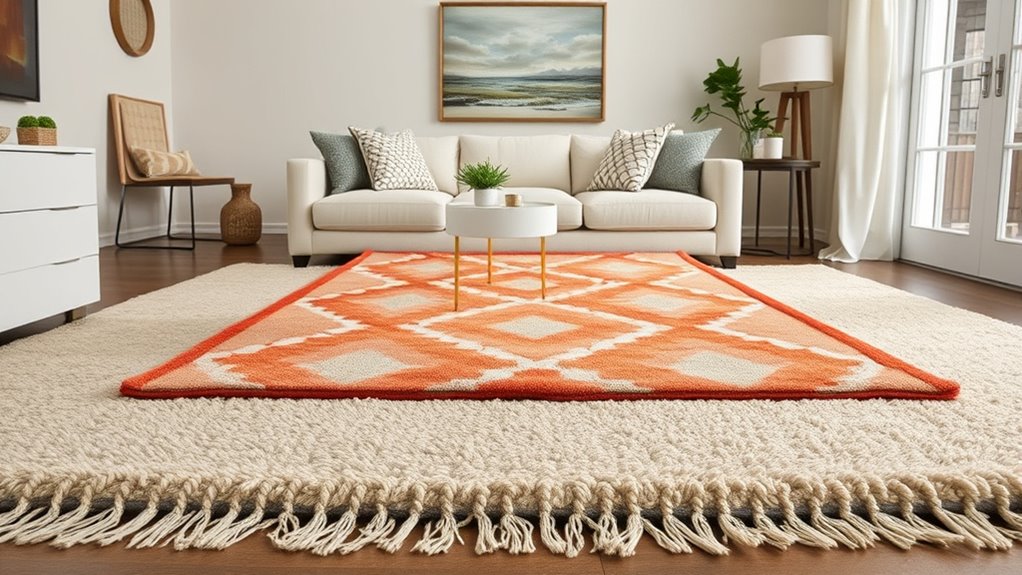
Layering rugs adds depth and personality to your space by mixing patterns, textures, and sizes. This technique creates visual interest and makes your room feel more dynamic. Start by choosing a larger, neutral or solid rug as a base. Then, add smaller rugs on top, experimenting with different textures like shag, woven, or flatweave. Play with contrasting patterns or similar tones for a cohesive look. Overlap the edges slightly to avoid rigid lines, and consider varying the pile height for added texture. Layering works well in living rooms, bedrooms, or lounges, making them feel cozy and curated. Keep in mind that the top rug should complement the base, and both should fit comfortably within the space without overwhelming it.
Keep Proportions in Mind for a Harmonious Balance
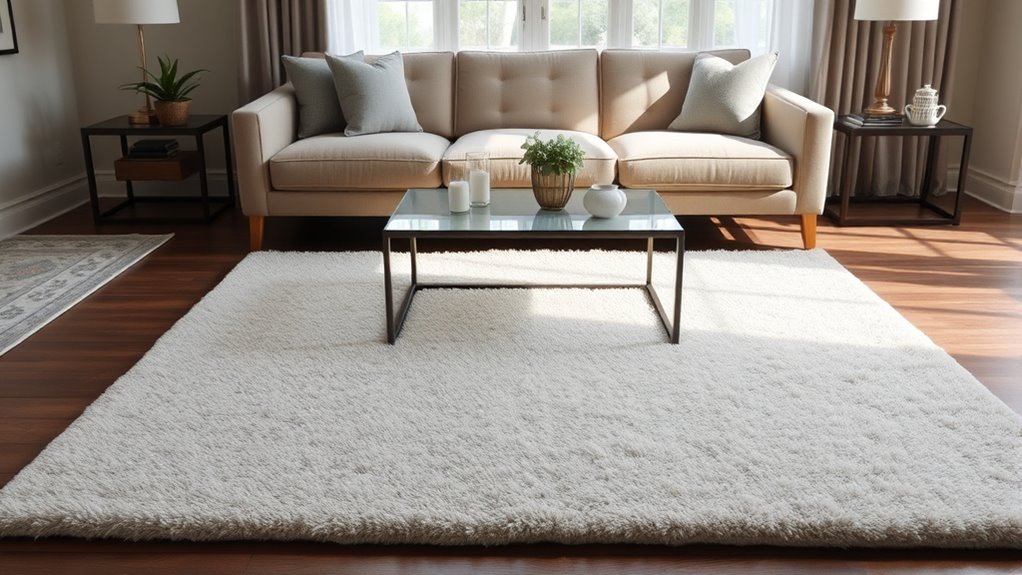
To create a balanced and visually pleasing rug arrangement, paying attention to proportions is essential. First, guarantee your rug complements the size of your furniture and room. A rug that’s too small can make the space feel disjointed, while one that’s too large might overwhelm the room. Here are three key tips:
- Measure your furniture and aim for the rug to extend at least 18 inches beyond the edges of your seating.
- Keep the rug’s width proportional to the room’s dimensions—roughly two-thirds the room’s width works well.
- For dining areas, allow enough space around the table so chairs stay on the rug when pulled out.
These guidelines help create harmony, making your space feel thoughtfully designed and inviting.
Frequently Asked Questions
How Do I Choose a Rug Color That Complements My Room Decor?
Choosing a rug color that complements your room decor starts with analyzing your existing palette. You should pick a hue that either matches or contrasts harmoniously with your wall colors, furniture, or accents. If your room has bold patterns, opt for a neutral rug to balance it out. Alternatively, select a color that adds a pop of interest. Trust your instincts and aim for a cohesive, inviting look.
What Are the Best Rug Sizes for Small or Oddly Shaped Rooms?
When selecting rug sizes for small or oddly shaped rooms, you should prioritize proportion and function. Opt for a smaller rug that fits comfortably without overwhelming the space, like a 5×8 or 6×9, ensuring furniture legs stay on the rug for cohesion. For oddly shaped rooms, choose custom-sized rugs or layered mats to fit irregular areas. Always aim for balance, so the rug enhances rather than dominates your room.
How Can I Prevent Rugs From Slipping or Sliding on the Floor?
To stop your rugs from slipping, you can use a non-slip rug pad underneath. Make sure the pad fits your rug size perfectly for maximum grip. You might also consider applying double-sided carpet tape to the underside of the rug’s edges or corners. Additionally, choose a rug with a textured backing or add rugs grippers at each corner. These tricks keep your rug securely in place and prevent accidents.
Should Rugs Be Oversized or Under-Scaled for Specific Furniture Arrangements?
Isn’t it tempting to think bigger is better? But, when choosing rugs for your furniture, size truly matters. You should aim for an oversized rug that anchors the space, allowing furniture to sit partially on it, creating a cohesive look. Avoid under-scaled rugs that seem lost or disconnected. By balancing size with your furniture, you craft a harmonious and inviting room that feels just right.
How Often Should I Clean or Replace My Area Rugs for Longevity?
You should clean your area rugs regularly, ideally every 12 to 18 months, depending on foot traffic and use. Vacuum frequently to remove dirt and debris, and spot clean spills promptly. Replace your rug when it shows significant wear, stains, or loss of color that cleaning can’t fix. Proper maintenance extends its lifespan, keeps it looking fresh, and preserves its quality, ensuring your space stays inviting and stylish for years to come.
Conclusion
When choosing the right rug size and placement, you might wonder if bigger is always better. Studies show that appropriately scaled rugs can actually make your space feel larger and more balanced. By following these expert tricks, you’ll create a harmonious look that feels both intentional and inviting. Remember, the right rug isn’t just about size—it’s about enhancing your room’s layout and style effortlessly. So trust your instincts and measure twice for perfect placement.
